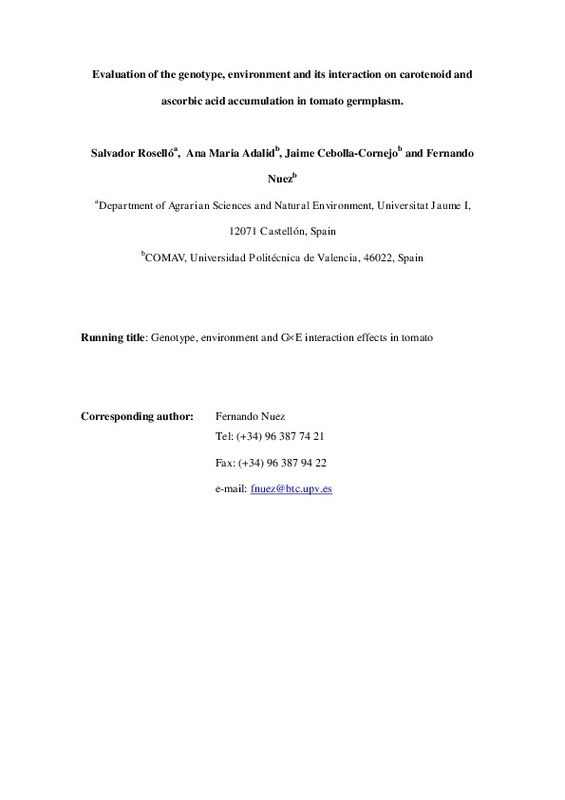Bouma, J., Varallyay, G., & Batjes, N. . (1998). Principal land use changes anticipated in Europe. Agriculture, Ecosystems & Environment, 67(2-3), 103-119. doi:10.1016/s0167-8809(97)00109-6
Menrad, K. (2003). Market and marketing of functional food in Europe. Journal of Food Engineering, 56(2-3), 181-188. doi:10.1016/s0260-8774(02)00247-9
Beecher, G. R. (1998). Nutrient Content of Tomatoes and Tomato Products. Experimental Biology and Medicine, 218(2), 98-100. doi:10.3181/00379727-218-44282a
[+]
Bouma, J., Varallyay, G., & Batjes, N. . (1998). Principal land use changes anticipated in Europe. Agriculture, Ecosystems & Environment, 67(2-3), 103-119. doi:10.1016/s0167-8809(97)00109-6
Menrad, K. (2003). Market and marketing of functional food in Europe. Journal of Food Engineering, 56(2-3), 181-188. doi:10.1016/s0260-8774(02)00247-9
Beecher, G. R. (1998). Nutrient Content of Tomatoes and Tomato Products. Experimental Biology and Medicine, 218(2), 98-100. doi:10.3181/00379727-218-44282a
Mayne, S. T. (1996). Beta-carotene, carotenoids, and disease prevention in humans. The FASEB Journal, 10(7), 690-701. doi:10.1096/fasebj.10.7.8635686
Lenucci, M. S., Caccioppola, A., Durante, M., Serrone, L., Piro, G., & Dalessandro, G. (2007). CAROTENOIDS CONTENT IN RIPE RAW AND PROCESSED (SAUCE) BERRIES OF HIGH PIGMENT TOMATO HYBRIDS. Acta Horticulturae, (758), 173-180. doi:10.17660/actahortic.2007.758.19
Stevens, M. A., & Rick, C. M. (1986). Genetics and breeding. The Tomato Crop, 35-109. doi:10.1007/978-94-009-3137-4_2
Hanson, P. M., Yang, R., Wu, J., Chen, J., Ledesma, D., Tsou, S. C. S., & Lee, T.-C. (2004). Variation for Antioxidant Activity and Antioxidants in Tomato. Journal of the American Society for Horticultural Science, 129(5), 704-711. doi:10.21273/jashs.129.5.0704
Abushita, A. A., Daood, H. G., & Biacs, P. A. (2000). Change in Carotenoids and Antioxidant Vitamins in Tomato as a Function of Varietal and Technological Factors. Journal of Agricultural and Food Chemistry, 48(6), 2075-2081. doi:10.1021/jf990715p
Adalid, A. M., Roselló, S., & Nuez, F. (2010). Evaluation and selection of tomato accessions (Solanum section Lycopersicon) for content of lycopene, β-carotene and ascorbic acid. Journal of Food Composition and Analysis, 23(6), 613-618. doi:10.1016/j.jfca.2010.03.001
Hamner, K. C., Bernstein, L., & Maynard, L. A. (1945). Effects of Light Intensity, Day Length, Temperature, and Other Environmental Factors on the Ascorbic Acid Content of Tomatoes. The Journal of Nutrition, 29(2), 85-97. doi:10.1093/jn/29.2.85
Kuti, J. O., & Konuru, H. B. (2005). Effects of genotype and cultivation environment on lycopene content in red-ripe tomatoes. Journal of the Science of Food and Agriculture, 85(12), 2021-2026. doi:10.1002/jsfa.2205
Lavi, N., Tadmor, Y., Meir, A., Bechar, A., Oren-Shamir, M., Ovadia, R., … Levin, I. (2009). Characterization of theINTENSE PIGMENTTomato Genotype Emphasizing Targeted Fruit Metabolites and Chloroplast Biogenesis. Journal of Agricultural and Food Chemistry, 57(11), 4818-4826. doi:10.1021/jf900190r
Galiana-Balaguer, L., Roselló, S., Herrero-Martı́nez, J. M., Maquieira, A., & Nuez, F. (2001). Determination of -Ascorbic Acid in Lycopersicon Fruits by Capillary Zone Electrophoresis. Analytical Biochemistry, 296(2), 218-224. doi:10.1006/abio.2001.5297
Zhu, J., & Weir, B. S. (1996). Diallel analysis for sex-linked and maternal effects. Theoretical and Applied Genetics, 92(1), 1-9. doi:10.1007/bf00222944
Rao, C. R. (1971). Estimation of variance and covariance components—MINQUE theory. Journal of Multivariate Analysis, 1(3), 257-275. doi:10.1016/0047-259x(71)90001-7
Benjamini, Y., & Hochberg, Y. (2000). On the Adaptive Control of the False Discovery Rate in Multiple Testing With Independent Statistics. Journal of Educational and Behavioral Statistics, 25(1), 60-83. doi:10.3102/10769986025001060
Holden, J. M., Eldridge, A. L., Beecher, G. R., Marilyn Buzzard, I., Bhagwat, S., Davis, C. S., … Schakel, S. (1999). Carotenoid Content of U.S. Foods: An Update of the Database. Journal of Food Composition and Analysis, 12(3), 169-196. doi:10.1006/jfca.1999.0827
Gould, W. A. (1992). Tomato Production, Processing and Technology. doi:10.1533/9781845696146
Shigeoka, S. (2002). Regulation and function of ascorbate peroxidase isoenzymes. Journal of Experimental Botany, 53(372), 1305-1319. doi:10.1093/jexbot/53.372.1305
Adalid, A. M., Roselló, S., Cebolla-Cornejo, J., & Nuez, F. (2008). EVALUATION AND SELECTION OF LYCOPERSICON ACCESSIONS FOR HIGH CAROTENOID AND VITAMIN C CONTENT. Acta Horticulturae, (789), 221-228. doi:10.17660/actahortic.2008.789.30
Leoni, C. (1992). INDUSTRIAL QUALITY AS INFLUENCED BY CROP MANAGEMENT. Acta Horticulturae, (301), 177-184. doi:10.17660/actahortic.1992.301.20
Hamauzu, Y., Chachin, K., & Ueda, Y. (1998). Effect of Postharvest Storage Temperature on the Conversion of 14C-Mevalonic Acid to Carotenes in Tomato Fruit. Engei Gakkai zasshi, 67(4), 549-555. doi:10.2503/jjshs.67.549
McCOLLUM, J. P. (1954). EFFECTS OF LIGHT ON THE FORMATION OF CAROTENOIDS IN TOMATO FRUITS. Journal of Food Science, 19(1-6), 182-189. doi:10.1111/j.1365-2621.1954.tb17437.x
Baqar, M. R., & Lee, T. H. (1978). Interaction of CPTA and High Temperature on Carotenoid Synthesis in Tomato Fruit. Zeitschrift für Pflanzenphysiologie, 88(5), 431-435. doi:10.1016/s0044-328x(78)80259-1
LIPTAY, A., PAPADOPOULOS, A. P., BRYAN, H. H., & GULL, D. (1986). Ascorbic acid levels in tomato (Lycopersicon esculentum Mill.) at low temperatures. Agricultural and Biological Chemistry, 50(12), 3185-3187. doi:10.1271/bbb1961.50.3185
Adegoroye, A. S., & Jolliffe, P. A. (1987). Some inhibitory effects of radiation stress on tomato fruit ripening. Journal of the Science of Food and Agriculture, 39(4), 297-302. doi:10.1002/jsfa.2740390404
Hirschberg, J. (2001). Carotenoid biosynthesis in flowering plants. Current Opinion in Plant Biology, 4(3), 210-218. doi:10.1016/s1369-5266(00)00163-1
Martínez-Valverde, I., Periago, M. J., Provan, G., & Chesson, A. (2002). Phenolic compounds, lycopene and antioxidant activity in commercial varieties of tomato (Lycopersicum esculentum). Journal of the Science of Food and Agriculture, 82(3), 323-330. doi:10.1002/jsfa.1035
[-]






![[Cerrado]](/themes/UPV/images/candado.png)



